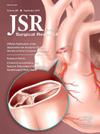Feasibility of Low-Volume Atomized Povidone-Iodine as a Peritoneal Antiseptic in Complicated Appendicitis
IF 1.7
3区 医学
Q2 SURGERY
引用次数: 0
Abstract
Introduction
Pediatric complicated appendicitis carries significant risk of abscess formation. Current surgical techniques for reduction of postoperative abscess include suction, irrigation with saline or dilute povidone-iodine, or drain placement. However, these approaches are not supported by high-quality evidence. This study aims to investigate the feasibility of administering low-volume atomized povidone-iodine (LVAP) as an antiseptic technique for complicated appendicitis.
Materials and Methods
A retrospective case-control study of pediatric complicated appendectomies was performed at a children's hospital from 2020 to 2024. Extent of perforation was characterized as contained infection versus uncontained infection with widespread peritonitis. LVAP comprised of 5-10 cc of finely misted, nondilute povidone-iodine applied to areas of peritoneal contamination using a customized hand-powered nozzle via a standard working 5 mm trocar over approximately 15 s. Treatment was recorded as LVAP versus standard practice (suction or saline irrigation). Clinical results were compared in a stratified matching analysis.
Results
A total of 25 patients underwent LVAP and 340 underwent standard practice. Following 2:1 matching, 50 standard practice controls were included. No adverse sequelae of LVAP were noted. No statistically significant difference was detected between abscess rates following LVAP versus standard practice (16% (4/25) versus 24% (12/50), P = 0.56), though no abscesses were seen following LVAP administration for contained infection.
Conclusions
LVAP is a novel, feasible operative technique for complicated pediatric appendicitis. Though we were unable to demonstrate statistical significance, our observations of LVAP in reducing abscess rates for contained infection are promising. We are now able to estimate appropriate sample sizes needed to achieve sufficient power for a future study.
小体积雾化聚维酮碘作为复杂性阑尾炎腹膜杀菌剂的可行性。
儿童复杂性阑尾炎具有脓肿形成的显著风险。目前减少术后脓肿的手术技术包括抽吸、生理盐水或稀聚维酮碘冲洗或引流。然而,这些方法没有高质量的证据支持。本研究旨在探讨小体积雾化聚维酮碘(LVAP)作为复杂阑尾炎消毒技术的可行性。材料与方法:对某儿童医院2020 - 2024年儿科复杂阑尾切除术病例进行回顾性病例对照研究。穿孔程度的特征为隐蔽性感染与无隐蔽性感染合并广泛腹膜炎。LVAP由5-10毫升精细雾化的非稀释聚维酮碘组成,使用定制的手动喷嘴通过标准工作的5毫米套管针,在大约15秒内涂抹在腹膜污染区域。治疗记录为LVAP与标准做法(抽吸或盐水冲洗)。采用分层匹配分析比较临床结果。结果:25例患者接受了LVAP治疗,340例患者接受了标准治疗。按照2:1匹配,纳入50个标准实践对照。没有发现LVAP的不良后遗症。LVAP治疗后的脓肿率与标准治疗相比无统计学差异(16% (4/25)vs 24% (12/50), P = 0.56),但LVAP治疗后未见脓肿。结论:LVAP是一种治疗小儿复杂性阑尾炎的新颖可行的手术技术。虽然我们无法证明统计学意义,但我们观察到LVAP在降低脓疡率方面是有希望的。我们现在能够估计出适当的样本量,以达到未来研究所需的足够功率。
本文章由计算机程序翻译,如有差异,请以英文原文为准。
求助全文
约1分钟内获得全文
求助全文
来源期刊
CiteScore
3.90
自引率
4.50%
发文量
627
审稿时长
138 days
期刊介绍:
The Journal of Surgical Research: Clinical and Laboratory Investigation publishes original articles concerned with clinical and laboratory investigations relevant to surgical practice and teaching. The journal emphasizes reports of clinical investigations or fundamental research bearing directly on surgical management that will be of general interest to a broad range of surgeons and surgical researchers. The articles presented need not have been the products of surgeons or of surgical laboratories.
The Journal of Surgical Research also features review articles and special articles relating to educational, research, or social issues of interest to the academic surgical community.

 求助内容:
求助内容: 应助结果提醒方式:
应助结果提醒方式:


